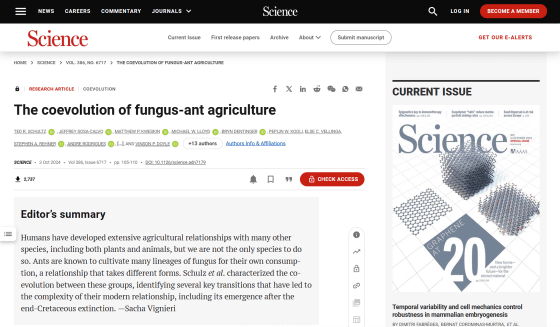Research reveals that the meteorite impact that wiped out the dinosaurs led to the birth of 'ant farming'

The beginning of agriculture can be said to have been a revolution that greatly advanced humanity, but in fact, it is not only humans who practice agriculture. It is known that ants also
The coevolution of fungus-ant agriculture | Science
https://www.science.org/doi/10.1126/science.adn7179

Ants learned to farm fungi during a mass extinction - Ars Technica
https://arstechnica.com/science/2024/10/ants-fungus-agriculture-traced-back-to-dinosaur-killing-impact/
Dinosaur extinction led to the emergence of 'ant agriculture' - Earth.com
https://www.earth.com/news/dinosaur-extinction-led-to-the-emergence-of-ant-agriculture/
Ants such as leaf-cutter ants, which are found widely from the southeastern part of North America to Central and South America, form a symbiotic relationship with certain fungi, transporting plants and other nutrients that serve as a source of nutrition for the fungus and helping it grow, in exchange for which they use the fungus as food for themselves.
Previous genetic studies have shown that the symbiotic relationship between ants and fungi is very specific, with certain ants only cooperating with certain fungi. It is also believed that genes that appear to have evolved rapidly in response to the cooperating fungi contribute to the symbiotic relationship, but it was not clear how this symbiotic relationship arose.
So an international team of researchers analyzed the DNA of 276 ant species and 475 fungi species to explore the origins of the symbiotic relationship between ants and fungi. The ants and fungi studied included species that engage in 'ant farming' as well as closely related, non-farming species, and the team analyzed more than 2,000 genes to estimate which species are most closely related and when they diverged from a common ancestor.

The team divided the ants into three groups based on the type of agriculture they practice: 'a group that cultivates yeast,' 'a group that cultivates
The analysis revealed that if agricultural ants are traced back to their most recent common ancestor, it is likely that that common ancestor survived a mass extinction event about 66 million years ago , and that the two different fungi cultivated by modern leaf-cutter ants emerged at roughly the same time about 66 million years ago.
The mass extinction event about 66 million years ago is believed to have been caused by a massive asteroid impact on Earth, which caused major climate change and a lack of sunlight. The lack of sunlight caused by the meteorite impact is said to have hindered plant photosynthesis for about two years, which is thought to have favored the growth of fungi.

It is believed that most of the ants that actually engage in agriculture appeared towards the end of the Eocene epoch , about 33 million years ago after the mass extinction. This study also suggests that climate change during the transition from the Eocene to the Oligocene epoch, and the spread of savannah-like environments about 27 million years ago, may have promoted the diversification of ants and the evolution of fungi.
These results suggest that the origin of fungus cultivation by ants may be an adaptation to the nutritional crisis that ants faced after the meteorite impact. Professor André Rodríguez of the Institute of Biological Sciences of the State University of São Paulo, co-author of the paper, said, 'The ancestors of the leaf-cutting ant group lived in close proximity to fungi and probably fed on them or their by-products. 'While the origin of fungus-cultivating ants was relatively well understood, a more precise timeline for these microorganisms was lacking. This study provides the most accurate results to date on the emergence of these fungi, which were previously thought to be more recent.'
Related Posts:







